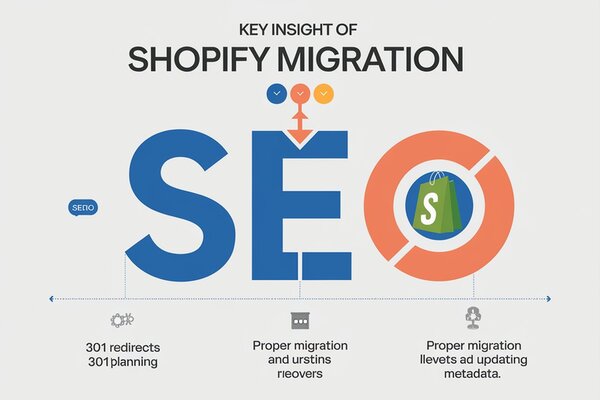
Shopify is a robust eCommerce platform, and migrating your website to Shopify can unlock numerous benefits, including enhanced functionality and scalability. However, one critical concern during such a migration is the impact on your SEO performance. This process can feel like walking a tightrope—migrate successfully, and you maintain your rankings; missteps, however, could see your SEO traffic plummet.
Migrating a website to Shopify involves many intricate steps that affect your SEO, from URL structure changes to meta tags and content migration. Whether you're handling the migration yourself or seeking the help of a Shopify website development service, understanding what happens to your SEO after Shopify migration is crucial.
Why SEO Matters in Shopify Migration
SEO is the lifeblood of your website's visibility. When migrating to Shopify, the last thing you want is to lose all the hard-earned organic traffic. Search engines index your current website based on the structure of its URLs, internal links, and content. Changing any of these elements could have a dramatic impact on your SEO rankings.
Let’s break down why SEO is so critical during Shopify migration:
Preserving rankings: Your existing pages likely hold SEO value. A smooth migration ensures that search engines can continue to rank your pages without penalizing you for technical changes.
Maintaining organic traffic: If done correctly, migrating to Shopify will not hurt your current traffic levels. Conversely, mistakes could result in a severe traffic drop, affecting revenue.
Optimizing for growth: Post-migration, Shopify’s SEO-friendly features offer growth opportunities, from improved mobile optimization to faster load speeds, both of which are ranking factors.
Migrating without paying attention to SEO is like playing with fire—you risk burning everything down. This is why many businesses choose to hire Shopify developers experienced in managing SEO during the migration process.
Impact of Migration on SEO Performance
When it comes to migration, several SEO factors can be influenced. Here’s a list of common areas where SEO might be affected:
URL Changes: If your URL structure changes, it can confuse search engines, leading to ranking drops. Redirects should be used carefully to preserve link equity.
Internal Links: Shopify’s structure might alter how your internal links are set up, which can affect how search engines crawl your site.
Meta Tags and Descriptions: Meta titles, descriptions, and alt texts for images might be lost during migration if not handled correctly, which can hurt your on-page SEO.
Loading Speed: Shopify websites are often faster, but ensure that the migration does not lead to technical issues that slow down the site.
Broken Links: Unchecked, migration can result in broken links, which negatively impact SEO.
Understanding how each of these aspects could affect your SEO is essential to minimize potential losses and to be prepared for the necessary steps to mitigate risks.
How to Retain SEO Rankings After Shopify Migration
Retaining your SEO rankings after migration doesn’t happen by accident. Here’s a simple checklist to follow to ensure minimal disruption to your SEO efforts:
301 Redirects: Use permanent 301 redirects to point old URLs to the new Shopify URLs. This tells search engines that the page has moved permanently, ensuring that link equity is preserved.
Audit the Current Site: Before migrating, audit your current site for its top-performing pages, metadata, and keywords to ensure you retain them after the migration.
Optimize Content: Keep your content intact while improving it to better match user intent, updating any outdated information, and adding additional SEO-rich keywords.
Test for Broken Links: After migration, thoroughly test the new site for any broken internal or external links and fix them promptly.
Submit a New Sitemap: Once the migration is complete, generate and submit a new XML sitemap to search engines to help them crawl the new Shopify site efficiently.
SEO Best Practices During Shopify Migration
Implementing SEO best practices during your Shopify migration will help safeguard your rankings and even enhance your SEO post-migration. Here’s what you should focus on:
Maintain URL Structures: Wherever possible, keep your URL structure consistent with the original site. If changes are unavoidable, ensure that 301 redirects are implemented properly.
Optimize for Mobile: Shopify has excellent mobile optimization features, but ensure your theme is responsive to capture mobile traffic, as it’s a critical SEO factor.
Use SEO Apps: Shopify has an array of SEO apps that can help manage redirects, fix broken links, and optimize meta tags.
Keep Track of Analytics: After migration, monitor your analytics to check for any SEO dips. Immediate action should be taken if you notice drops in rankings or traffic.
Canonical Tags: Ensure that Shopify’s canonical tags are correctly configured to avoid duplicate content issues.
Incorporating these best practices helps maintain a stable SEO foundation during and after the migration, allowing you to hit the ground running in your new Shopify environment.
Benefits of Hiring a Shopify Developer for SEO Management
Migrating to Shopify while maintaining your SEO is no small feat. A hire Shopify developer can make the entire process seamless, ensuring that no crucial aspect of your SEO is neglected. Here are some benefits of bringing in a pro:
Technical Expertise: Developers understand how to implement 301 redirects, ensure mobile optimization, and maintain proper URL structures during migration.
SEO Strategy Alignment: They can align your SEO strategy with Shopify’s technical capabilities, ensuring no conflicts arise.
Post-Migration Monitoring: A skilled Shopify developer will monitor your SEO performance post-migration and address any unforeseen issues quickly.
Advanced Customization: With the help of a developer, you can further customize your Shopify site to include schema markups, optimize product pages, and more.
The smooth execution of your migration can set your business up for success, which is why hiring a Shopify developer with SEO expertise can save you headaches down the road.
FAQs
1. Will my website lose its SEO ranking after migrating to Shopify? If migration is done correctly with proper redirects and SEO strategies in place, your rankings should not suffer. However, a poorly managed migration can result in ranking drops.
2. How long does it take for SEO to stabilize after migration? It typically takes a few weeks for search engines to re-index your new Shopify site, but it can take up to a few months to see full results.
3. What are the common SEO mistakes during Shopify migration? Common mistakes include not implementing 301 redirects, ignoring mobile optimization, and failing to transfer metadata like title tags and descriptions.
4. Can I handle Shopify migration on my own? You can, but hiring a Shopify developer is recommended if you lack technical expertise, especially when it comes to preserving your SEO.
5. Do I need to re-optimize my content after migration? Yes, it's an excellent opportunity to review and improve your content for better SEO performance, focusing on adding relevant keywords and improving readability.
Conclusion
Migrating your eCommerce store to Shopify offers a world of opportunities, but it’s crucial to manage the SEO impact with care. The process involves more than just moving content—it requires preserving your SEO rankings, maintaining traffic, and ensuring that your site remains discoverable. By implementing best practices such as 301 redirects, keeping a consistent URL structure, and using Shopify’s SEO tools, you can safeguard your rankings during the transition.
Hiring a skilled Shopify developer can ease the complexities of migration, ensuring your SEO remains intact while capitalizing on Shopify’s robust features. With the right approach, migrating to Shopify can enhance not only your store's performance but also its visibility online, setting your business up for long-term success.
In the end, a well-executed migration should lead to an even stronger SEO presence, helping your Shopify store thrive in the competitive eCommerce landscape.
















.png)
.png)








Leave Your Comment & Rating Below
0 Comment(s)